Wondering how you can beef up your website security?
WordPress security is a very important topic for every website owner, as it has many implications for the success of your website.
Thankfully, WordPress has done a lot to ensure the platform is secure. However, WordPress's most prominent feature is also its Achilles' heel: the fact that it's an open-source content management system (CMS). Because anyone can modify the source code, many plugins, themes, and other tools are developed to integrate with and even change the code. These can open up your website to different critical vulnerabilities that can compromise the integrity of your website.
That's why you need to take measures to improve your website security.
Don't worry. Though this may sound like a challenging task, securing your WordPress website is easy if you take the proper steps.
Why is Website Security Important?
Whether you're running a hobby site, business website, affiliate marketing website, or any other type of website, keeping it secure must always be a priority.
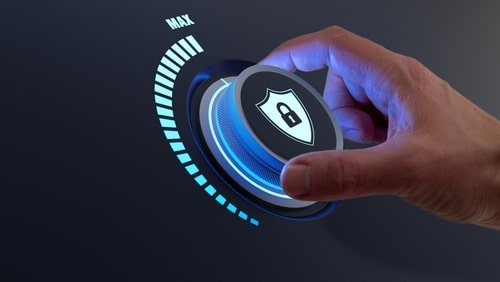
Here are four main reasons why website security is important:
- Protect your information: Security breaches can give attackers access to your or your customers' valuable information. This is information they can use for many malicious activities that can harm.
- Protect your reputation: When people discover that your website is vulnerable to attacks, your reputation will be compromised. As a result, you could lose customers.
- Website visitors expect it: Website visitors are more comfortable browsing websites with good security. Therefore, if your website shows any signs of not being secure, it could lead to higher bounce rates and lower conversions.
- Search engines promote secure websites: Website security plays a huge role in your SEO strategy. That's because search engines prefer secure websites to those that aren't.
Now that you know a few reasons why website security is important, let's look at some website security issues you need to be aware of.
Website Security: 5 Types of WordPress Security Vulnerabilities and Attacks to Know
To beef up your website security, you must know the different vulnerabilities and attacks to protect yourself against. Below are the five common ones:
1. Phishing
Phishing is when an attacker contacts you, posing as a legitimate company or service provider. The reason behind phishing attempts is to get you to divulge personal information, visit a dangerous website, or download malware. If a malicious agent gains access to your WordPress admin panel, they can even conduct phishing attacks on your customers while posing as you.
2. Brute Force Attacks
Brute force attacks are the simplest types of attacks on websites. These involve attackers using automation to enter many different username-password combinations with the hope of getting the right combination.
3. Backdoors
A backdoor attack is a website security breach whereby hackers install malware that can bypass your standard WordPress login. This enables attackers to access your site at any time. To execute a backdoor attack, hackers place a backdoor among other WordPress source files that are legitimate or seem legitimate. To reduce the chance of backdoors, WordPress restricts and monitors the types of files users can upload. However, this is still a type of attack to be aware of.
4. Denial-of-Service (DoS) Attacks
DoS attacks are carried out to prevent authorized users from accessing a website or network. This is usually achieved by driving an overwhelming amount of traffic to a website, causing it to crash. The effects of this type of attack are worsened in the case of a distributed denial-of-service attack (DDoS). A DDoS is carried out on multiple compromised computers at once.
Often, this type of attack results in the perpetrators holding your website hostage and demanding a ransom to end the service disruption.
5. SQL Injections and Cross-site Scripting (XSS)
SQL injections and XSS both involve injecting malicious code to steal information or negatively impact a website's functionality. The difference is that SQL injection attacks directly target databases (your website). In contrast, XSS attacks direct users to compromised websites developed to steal visitors' data.
With the fundamentals sorted, let's get your website secured.
How to Boost Your Website Security — 8 Tips
Now that we've looked at the importance of website security and some of the security issues to prepare for let's dive into some measures you can take to secure your WordPress website.
1. Invest in a Security-Conscious Hosting Provider
When considering website security, one of the best places to start is your hosting provider of choice. Always go with a hosting provider that prioritizes security and shows it by offering security enhancement features as part of the package. These are features like web application firewalls (WAF), SSL/TLS certificates, and DDoS protection. A good hosting provider also:
- Monitors their network for security
- Keeps their hardware, PHP versions, and server software up to date to prevent hackers from exploiting known vulnerabilities
- Adds disaster recovery tools and strategies to their arsenal of tools in case of a successful breach
Apart from security, also consider support. With a good support team, your web host can help you quickly recover from a malicious attack.
If you need an excellent, security-conscious hosting provider, we recommend Bluehost and Siteground for shared hosting. For managed WordPress hosting, you can't get a better hosting provider than WPEngine. Having been in the business forever (well, almost), you can be assured these understand cybersecurity and how to keep your website safe.
2. Switch Your WordPress Site to SSL/HTTPS
Secure Sockets Layer (SSL) is a security protocol that encrypts the data transferred between your website and a user's browser. Encryption makes it harder for malicious actors to sniff around and steal information from you or your website visitors.
When you enable SSL, your website will start using the more hypertext transfer protocol secure (HTTPS) instead of hypertext transfer protocol (HTTP). Once you've done so, search engines will display a padlock sign next to your website address in the browser to show that you're using the more secure version.
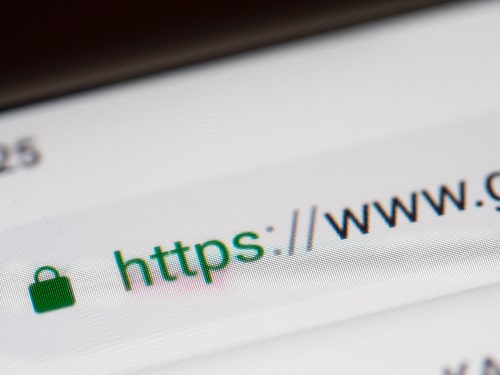
SSL certificates are issued by certificate authorities and come at a cost, with the best ones starting from $80 to thousands of dollars per year. Due to this added cost in running a website, many website owners were reluctant to switch to the more secure protocol. Thankfully, however, there are now many free SSL certificate providers on the market, so there's no excuse for you not to switch.
However, free SSL certificates are too limited to provide sufficient security if you accept payments on your website or handle very sensitive customer information. If you want a more robust SSL certificate than the free one that comes with your hosting, consider purchasing one from Domain.com. They have some of the best SSL deals on the market, especially considering their SSL certificates come with a $10,000 security warranty and a TrustLogo security seal.
If you haven't yet, move your site to HTTPS.
3. Always Update WordPress, Themes, and Plugins
Another way of ensuring your website security is always up to scratch is to keep WordPress updated. While WordPress automatically installs minor updates, you have to accept major ones. Apart from ensuring that WordPress is constantly updated, you should also be vigilant in keeping your themes and plugins updated as well.
In the same vein, carefully vet the themes and plugins you choose to install on your website. Ensure they're from reputable developers and that they're regularly updated.
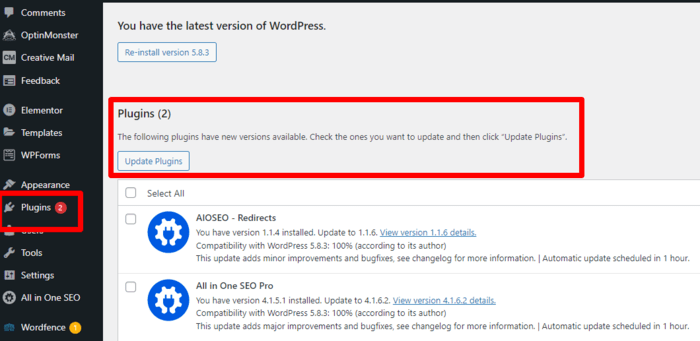
Failing to keep WordPress, your themes, and plugins updated will leave you open to security vulnerabilities. Always take the few moments required to keep everything updated. This can also include deleting old plugins and themes you aren't using.
4. Ensure Your Login Procedures are Secure
Most common attacks on websites involve stealing login credentials. That's why one of the most important steps to take in keeping your WordPress website secure is to ensure your login procedures are bulletproof.
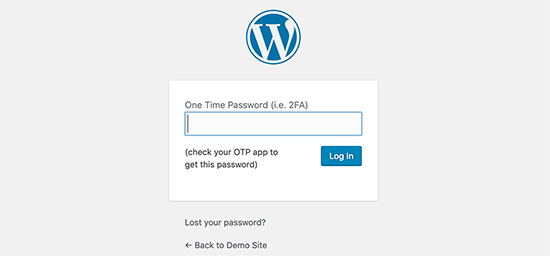
A few tips to help you do that include:
- Use strong passwords: Always ensure you and your users use strong passwords. One way to do this is to use a password manager to generate and manage everyone's passwords.
- Enable two-factor authentication (2FA): 2FA refers to a login process that requires two steps instead of the usual one step. The second step usually involves getting a code on a smartphone or other device. You'll need to install a tool like LastPass Authenticator or Authy to enable 2FA.
- Limit login attempts: Limiting the number of times a user can enter the wrong login credentials is an excellent way of preventing brute force attacks. A great plugin you can use for this is Limit Login Attempts Reloaded.
- Enable auto-logout: While most people log out of websites when they're done, it can be easy to forget. Malicious agents can snoop into that account and compromise it when that happens. Enabling auto-logout with a plugin like Inactive Logout will boost your website security.
- Avoid using “admin” in any user name: Administrator accounts are usually the first to be targeted in brute force attacks. That's why you should avoid using “admin” in any of your usernames.
Other login procedures to implement can include using a “captcha” plugin and avoiding granting many users admin access.
Making the login process secure makes it difficult for malicious actors to compromise your website.
5. Have a WordPress Backup Solution
No matter how much you may beef up your website security, it can never be 100%. That's why a significant part of your security strategy is to always have a backup of your website.

Backups enable you to quickly restore your website if anything happens to it. One of the most important factors to know about website backups is regularly saving full-site backups on a remote location and not your hosting account. We recommend storing your site backups on cloud services like Amazon, Dropbox, or even a private cloud service like Stash.
Thankfully, there are many WordPress backup plugins that you can use to backup your website— both free and paid. A couple of reliable ones include UpdraftPlus and BlogVault. An added advantage of these two plugins is that they're no-code plugins, making them beginner-friendly.
6. Install a WordPress Security Plugin
Besides backups, you also need to install and activate a WordPress security plugin.

This will help audit, monitor, and keep track of everything that happens on your website. Examples include, among other security issues:
- File integrity monitoring
- Failed login attempts
- Malware scanning
- Preventing hotlinking (a type of content theft)
One of the best free WordPress security plugins you can consider for this is Sucuri Scanner. You can also upgrade to their paid plans for more robust website security.
7. Enable a Web Application Firewall (WAF)
One of the best ways to secure your WordPress website is to use a web application firewall (WAF). That's because a WAF blocks all malicious traffic before it even reaches your website by filtering and monitoring traffic coming from the internet. Examples of attacks you can prevent using a WAF include XSS, SQL injection, cookie poisoning, and more.
Two examples of WAF levels you can implement on your website are:
- DNS level website firewall: This type of firewall will route your website traffic through cloud proxy servers, then filter the traffic coming to your site. Doing so allows the servers to only send genuine traffic to your web server.
- Application-level firewall: Unlike DNS firewalls that operate on a server level, application-level firewalls examine the traffic once it has passed your server but before loading any WordPress scripts.
Because of how they work, firewalls are a great way to prevent threats from reaching your website. However, they can and shouldn't be used alone but as part of a system of security measures.
Again, Sucuri works well in this department and comes highly recommended as a firewall solution. But you only get the firewall protection on the paid plans.
8. Lock Down Your File Permissions
Most of the information, data, and content on your website is stored in a series of files and folders. The said files and folders are organized in a hierarchical structure, with each having a permission level assigned to it. These permissions determine what users can do with the files, i.e., view, edit, or restrict certain users from having access.
You can access these from your cPanel, under the File Manager section.
In WordPress, file permissions are represented by a three-digit number, with each digit having a meaning. A typical example is 755.
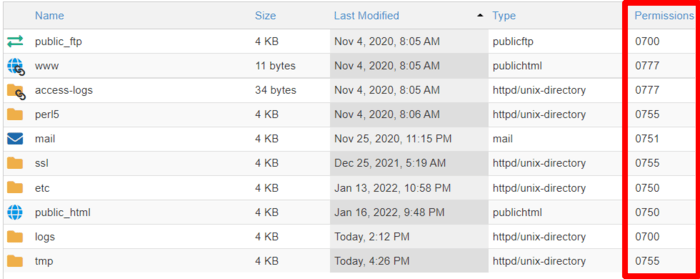
What do these numbers mean?
- The first digit stands for “User” or the individual responsible for the site.
- The second digit represents “Group” (members of your site.
- The third digit stands for “World” or every other visitor without any stake in your website.
Here's the code to help you decipher your file permissions levels:
0: No access to the file/folder
1: Can only execute the file/folder
2: Can edit the file/folder
3: Can edit and execute the file/folder
4: Can read the file/folder
5: Can read and execute the file/folder
6: Can read and edit the file/folder
7: Can read, edit, and execute the file/folder
Let's look at an example. Say a file has a permission level of 700. This means the user (site owner) can read, edit and execute the file, but everyone else has no access. On the other hand, everyone can read and execute a file with permission level 755, but only the site owner can edit it.
While this may seem complicated, knowing how to change permissions is another excellent way to secure your website. To change the permission level of a file or folder, click on it, then click on the permissions option in your cPanel menu.
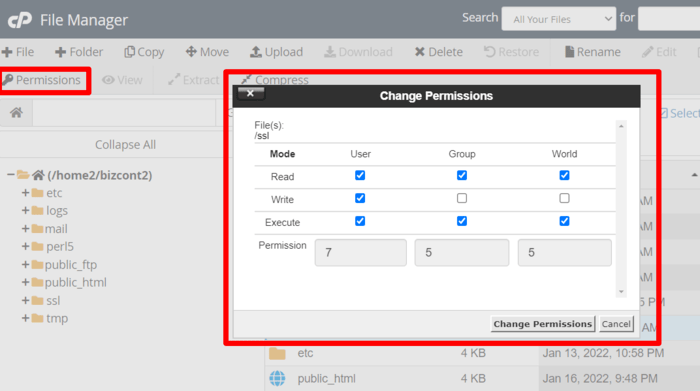
A window where you can edit the permissions for the file/folder will open.
Ensuring that each person only has the level of access to the different files and folders on your site is essential to having robust security on your site.
As a general rule of thumb, WordPress recommends setting folders to a permissions level of 755 and files to 644. However, you can set them to whichever level you deem fit. You just have to ensure you don't give any users more access than they need. This is especially for core files.
Website Security — There Should Be No Compromise
Website security is never to be taken lightly — you should never compromise in this area. After all, if your website is breached, you could spend days, weeks even, trying to repair the damage. In worst-case scenarios, you could even compromise your customers' data. Of course, this could cost you money and ruin your reputation.
That's why, when it comes to website security, you should always be proactive and not reactive.
Armed with these tips, go ahead and beef up your website security.
Besides beefing up your security, another element of success you need is to boost your SEO.
Thankfully, this isn't as complicated as the security aspect. That's especially with a powerful WordPress SEO plugin like AIOSEO. With AIOSEO, you can boost your website's SEO without touching a single line of code. Yes, that includes complex aspects like sitemaps, schema markup, redirects, and more.
As you work on improving your website security, be sure to download AIOSEO and increase your rankings.
Disclosure: Our content is reader-supported. This means if you click on some of our links, then we may earn a commission. We only recommend products that we believe will add value to our readers.
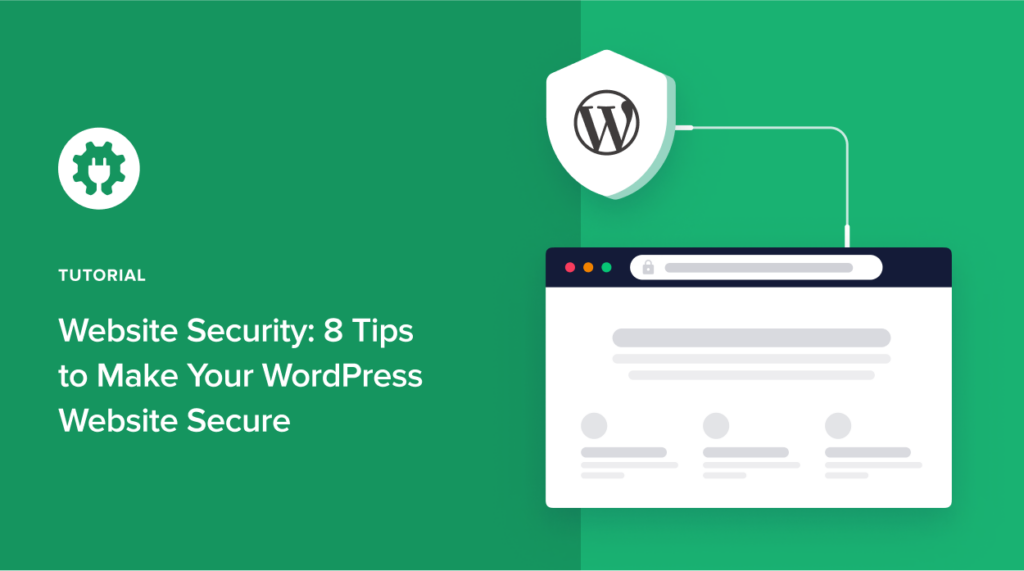

You have brought up a very wonderful points , thankyou for the post.
Thanks, Gregg!
Glad you enjoyed the post.
Excellent post. I am dealing with some of these issues as well..
Thank you so much for your kind words. we’re glad you found the article helpful.
Awesome article! You’ve broken down website security into clear, actionable steps—from updating plugins and using strong passwords to setting up SSL and regular backups. Practical and timely advice that every website owner should follow!